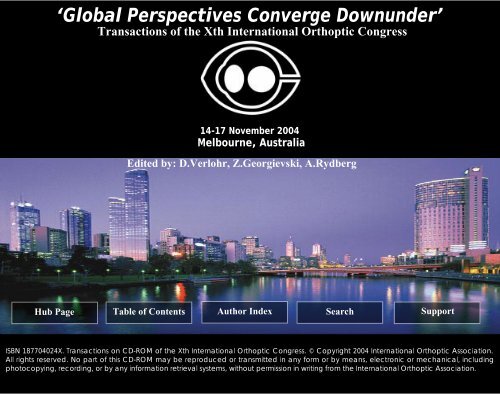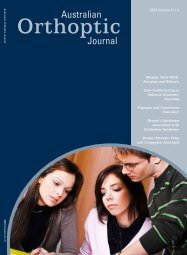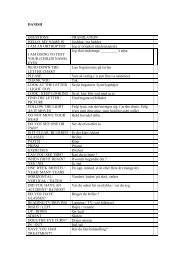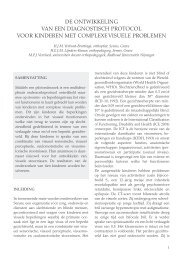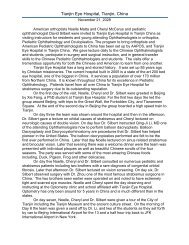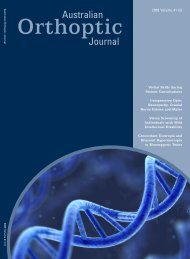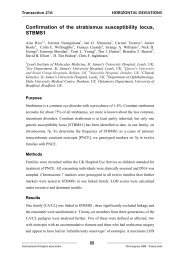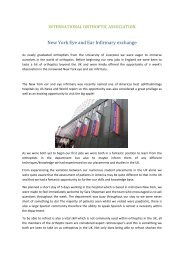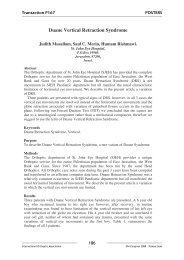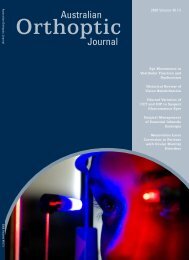Transactions from the Xth International Orthoptics Congress 2004
Transactions from the Xth International Orthoptics Congress 2004
Transactions from the Xth International Orthoptics Congress 2004
Create successful ePaper yourself
Turn your PDF publications into a flip-book with our unique Google optimized e-Paper software.
‘Global Perspectives Converge Downunder’<strong>Transactions</strong> of <strong>the</strong> <strong>Xth</strong> <strong>International</strong> Orthoptic <strong>Congress</strong>14-17 November <strong>2004</strong>Sydney AustraliaMelbourne, AustraliaEdited by: D.Verlohr, Z.Georgievski, A.Rydbergand t Institution of Engineers, Australia.Hub PageTable of ContentsAuthor Index Search SupportISBN 187704024X. <strong>Transactions</strong> on CD-ROM of <strong>the</strong> <strong>Xth</strong> <strong>International</strong> Orthoptic <strong>Congress</strong>. © Copyright <strong>2004</strong> <strong>International</strong> Orthoptic Association.All rights reserved. No part of this CD-ROM may be reproduced or transmitted in any form or by means, electronic or mechanical, includingphotocopying, recording, or by any information retrieval systems, without permission in writing <strong>from</strong> <strong>the</strong> <strong>International</strong> Orthoptic Association.
‘Global Perspectives Converge Downunder’- <strong>Xth</strong> <strong>International</strong> Orthoptic <strong>Congress</strong>Table of ContentsBurian LectureAmblyopiaBinocular VisionEye MovementsLow VisionNeuro-<strong>Orthoptics</strong>Ophthalmic Technology & Vision SciencePaediatric OphthalmologyProfessional Development & EducationPublic Health Agenda & ScreeningStrabismus - ConcomitantStrabismus - IncomitantStrabismus SurgerySymposia - AAPOS: Childhood Blindness Worldwide- ISA: Update on Chemical (or Pharmacological) Treatmentfor Strabismus- Vision Screening: Critical Appraisal of <strong>the</strong> Evidence inFavour (or not...!) of Vision Screening in ChildrenWorkshopsClicking on <strong>the</strong> items belowwill take you to <strong>the</strong> document= Abstract= Full PaperOral presentations in blackPosters in blue
‘Global Perspectives Converge Downunder’- <strong>Xth</strong> <strong>International</strong> Orthoptic <strong>Congress</strong>Strabismus - ConcomitantBinocular Single Vision in Surgically Treated Primary Constant Exotropia — A.L.Ansons, A.M.Ansons (UK)A High Frequency of Abnormal Orthoptic Findings in Children Adopted <strong>from</strong> Eastern Europe — Eva Aring,Marita Andersson Gronlund, Ann Hellstrom (Sweden)The Effect of Refractive Surgery on <strong>the</strong> Angle of Deviation in <strong>the</strong> Strabismic Patient — Carolyn Calcutt (UK)Intermittent Exotropia is not Always a Progessive Condition — Michael Clarke, S.Richardson, H.Haggerty,S.Hrisos, N.Strong (UK)The Natural History of X(T) Revisited —Stephanie Dotchin, Kenneth Romanchuk, Jocelyn Zurevinsky (Canada)A Systematic Review of Interventions for Infantile Esotropia — Sue Elliott, A.Shafiq (UK)Effect of Refractive Surgery on Binocular Vision and Ocular Alignment in Patients with Manifest or IntermittentStrabismus — Daisy Godts, J.Claeys, M.J.Tassignon (Belgium)Genetic Influence on Strabismus and Stereopsis in Children: The Twins Eye Study Tasmania — Lisa Kearns,S.Brown, J.MacKinnon, J.Poulsen, C.Hammond, L.Scotter, D.Mackey (Australia)New-Onset Childhood Accommodative Esotropia after Monocular Patching - Arif Khan (Saudi Arabia)
‘Global Perspectives Converge Downunder’- <strong>Xth</strong> <strong>International</strong> Orthoptic <strong>Congress</strong>Replacing <strong>the</strong> 6 Metre Test Distance with 3 Metre for Prism Cover Test Measurement — Rowena McNamara (UK)Longitudinal Evaluation of Control in Intermittent Exotropia — Brian Mohney, J.Holmes (USA)
A high frequency of abnormal orthoptic findings in children adopted<strong>from</strong> Eastern EuropeEva Aring, Marita Andersson Grönlund, Ann HellströmInstitute of Clinical Neuroscience, Section of Ophthalmology,The Sahlgrenska Academy at Göteborg University,S416 85 Göteborg, Sweden.Email: eva.aring@vgregion.seAbstractPurpose: To perform an orthoptic/ophthalmologic evaluation as part of a multidisciplinaryexamination in children adopted <strong>from</strong> Eastern Europe.Method: A prospective study was performed on 72/99 children adopted <strong>from</strong> Eastern Europe towestern Sweden. The children (41 boys, mean age 7.5 years) were compared with an age- andsex-matched reference group (“ref”).Results: Heterotropia was found in 32% of adoptees (ref 2%); <strong>the</strong> esotropia:exotropia ratio was2.3:1 (ref 2:0). The most common esotropia was concomitant non-accommodative esotropiawhile intermittent exotropia was <strong>the</strong> most common form of exotropia. Heterophoria was found in35% (ref 26%) and <strong>the</strong> exophoria:esophoria ratio was 3.2:1 (ref 6.7:1). The adoptees had largerheterophorian deviations both at distance and at near than did <strong>the</strong> reference group and <strong>the</strong> nearheterophoria:distance heterophoria ratio was 2:1 (ref 2.8:1). Stereo acuity was negative in 23%(ref 1%), subnormal (100–3 000”) in 21% (ref 1%) and normal (60” or better) in 56% of <strong>the</strong>adopted children (ref 98%).Motility disorders were noted in 26% of <strong>the</strong> children (ref 0%). The most frequently affectedmuscle was <strong>the</strong> inferior oblique with equal distribution of over- and under-action. Abnormalhead posture was found in 14% (ref 0%).A high frequency of refraction abnormalities and subnormal visual acuity (VA) was found.Fifteen per cent of <strong>the</strong> adopted children (ref 2%) had amblyopia.Conclusion: On <strong>the</strong> basis of <strong>the</strong> high occurrence of subnormal findings, we recommend that anorthoptic/ophthalmologic examination be performed among children adopted <strong>from</strong> EasternEurope after arrival in <strong>the</strong>ir new home country.Keywordsadopted children, amblyopia, eye motility, refraction, strabismusIntroductionSweden has one of <strong>the</strong> largest populations of international adoptees per capita in <strong>the</strong> world.The number of adoptees <strong>from</strong> Eastern Europe to Sweden has increased, and approximately1 000 children have arrived during <strong>the</strong> last decade. Previous studies reported that adoptedchildren <strong>from</strong> Eastern Europe to <strong>the</strong> United States and Great Britain were growth- anddevelopmentally delayed at arrival (1-3). Albers et al (3) reported single cases of ocularfindings, such as strabismus and optic nerve hypoplasia (ONH). To our knowledge, nodetailed orthoptic/ophthalmologic examination of adoptees <strong>from</strong> Eastern Europe has beenperformed.1
Therefore, <strong>the</strong> present orthoptic/ophthalmologic evaluation was initiated as a part of amultidisciplinary examination including a paediatric/neuropaediatric and psychologicalinvestigation.Material and MethodsAll children (n=99, 54 boys and 45 girls) born between 1990 and 1995, adopted during 1993–1997 <strong>from</strong> Poland, Romania, Russia, Estonia and Latvia through authorised adoption agenciesin Sweden and living in Västra Götaland region were invited to participate in <strong>the</strong> study. Aprospective study in 72 children (41 boys and 31 girls) was performed and <strong>the</strong> group werecompared with 90 age- and sex-matched Swedish school children (“ref”). The children’smean age at <strong>the</strong> evaluation was 7.5 years (range 4.8–10.5 years). There was no differenceregarding sex and age between <strong>the</strong> participants and <strong>the</strong> non-participants.Maternal alcohol abuse was suspected in twenty- four children (33%), according to <strong>the</strong> preadoptiondocuments. Forty-six per cent of <strong>the</strong> children were born small for gestational age,and 30% were considered to have been born pre-term. Detailed data on <strong>the</strong> adoptees’ healthbefore adoption, at <strong>the</strong> time of arrival and after 5 years in <strong>the</strong>ir new home country will bepresented elsewhere (Landgren M, unpublished data <strong>2004</strong>).Heterotropia was diagnosed with <strong>the</strong> monolateral cover test and heterophoria, with <strong>the</strong>alternate cover test at both 3 m (in five directions) and 0.3 m. The definition of “heterophoria”was a deviation ≥2 prism dioptre (pD). All measurements were performed with <strong>the</strong> alternateprism and cover test at <strong>the</strong> same distances and directions, with and without best correction.Stereo acuity was primarily investigated with <strong>the</strong> TNO test. Children who were unable toidentify <strong>the</strong> TNO figures were examined with <strong>the</strong> Lang 1 or Titmus test. Normal stereo acuitywas defined as 60” or better and subnormal acuity, as 100–3 000”.Statistical analysisFor a comparison between two groups, Mann-Whitney’s U-test was used for ordered andcontinuous variables; for dichotomous variables, Fisher’s exact test was used. All tests weretwo-tailed and conducted at <strong>the</strong> 5% significance level. The reference group for this study wasselected individual by individual by minimizing <strong>the</strong> maximal t-values between <strong>the</strong> group ofadopted children and a reference group of healthy Swedish school-aged children, over <strong>the</strong>variables age and sex.ResultsSeventy-eight per cent of <strong>the</strong> adopted children (ref 29%) had ocular findings of significance(p
20 222324.7
Though <strong>the</strong> vast majority of <strong>the</strong> children were in <strong>the</strong> care of an ophthalmologist or orthoptist,5/11 had had VA ≤0.15 in <strong>the</strong> amblyopic eye at 6 years of age. The reasons for this findingare most likely multifactorial. However, possible explanations might be that <strong>the</strong> framesreduced <strong>the</strong> advantage of <strong>the</strong>ir glasses (in <strong>the</strong> abnormal head postures) and/or that <strong>the</strong>amblyopia treatments were too much to handle for <strong>the</strong> adoptive families, in addition to all<strong>the</strong>ir o<strong>the</strong>r problems. The present study shows that adopted children <strong>from</strong> Eastern Europeneed an ophthalmologic evaluation after arrival in <strong>the</strong>ir new home country and that <strong>the</strong>y mayneed a great deal of support <strong>from</strong> <strong>the</strong> orthoptist/ophthalmologist carrying out <strong>the</strong> treatment.AcknowledgementsThe results have been presented at <strong>the</strong> XI Nordic Paediatric Ophthalmologic <strong>Congress</strong> held inUppsala, Sweden, in September 2003 and at <strong>the</strong> Scandinavian Orthoptic <strong>Congress</strong> held inStockholm, Sweden, in August <strong>2004</strong>.References1. Rutter M and <strong>the</strong> English and Romanian Adoptees (ERA) study team.(1998). Developmental catch-up, anddeficit, following adoption after severe global early privation. J Child Psychol Psychiat, 39, 465–475.2. Johnson DE, Miller LC, Iverson S et al. (1992). The health of children adopted <strong>from</strong> Romania. JAMA, 24,3446–3451.3. Albers LH, Johnson DE, Hosetter MK, Iverson S, Miller LC. (1997). Health of children adopted <strong>from</strong>former Soviet Union and Eastern Europe. Comparison with preadoptive medical records. JAMA, 278, 922–924.4. Hård A-L, Niklasson A, Svensson E, Hellström A. (2000). Visual function in school-aged children bornbefore 29 weeks of gestation: a population-based study. Dev Med Child Neurol, 42, 100–105.5. O’Connor AR, Stephenson TJ, Johnson A, Tobin MJ, Ratib S, Fielder AR. (2002). Strabismus in children ofbirth weight less than 1701 g. Arch Ophthalmol, 120, 767–773.6. Strömland K (<strong>2004</strong>). Fetal alcohol syndrome – a birth defect recognized worldwide. Fet Matern Medic Rev,15, 59–71.4
The effect of refractive surgery on <strong>the</strong> angle of deviation in<strong>the</strong> strabismic patient.Carolyn CalcuttCharing Cross HospitalFulham Palace RoadLondon W6 8RF,UKCarolynCalcutt@aol.comAbstractAs <strong>the</strong> number of patients seeking laser refractive surgery increases, so proportionally will <strong>the</strong>number who have had previous ocular motility disorders in childhood. Until now, <strong>the</strong>literature has consisted of ei<strong>the</strong>r case reports or small series <strong>from</strong> refractive surgeons where<strong>the</strong> emphasis has been on any improvement which may have resulted <strong>from</strong> <strong>the</strong> procedure, or<strong>from</strong> strabismologists who have drawn attention to <strong>the</strong> necessity for assessing <strong>the</strong> risk factorsfor unexpected post-laser strabismus and diplopia.Under our current protocol, patients with ei<strong>the</strong>r significant heterophoria, or a history ofstrabismus undergo a comprehensive ocular motility assessment prior to and where possible,after <strong>the</strong>ir refractive procedure. Any change in <strong>the</strong> deviation or binocular status posttreatmentare noted. In <strong>the</strong> present series, a total of 59 patients have been assessed of which47 cases had an esodeviation or exodeviation outside normal limits. Thirty eight of <strong>the</strong> totalhave proceeded to laser surgery. Preliminary results suggest that <strong>the</strong>re is a trend towards areduction in deviation in some cases, which must be taken into consideration with patientswhere <strong>the</strong>re is weak or absent binocular vision. It is hoped that fur<strong>the</strong>r ongoing post-laserassessments will suggest a predictive factor.KeywordsLaser refractive surgery, esotropia, exotropiaIntroduction.Laser refractive surgery is advertised as a life changing experience, and recent publications inrefractive surgery literature (1,2) have tended to suggest that it may even provide a viablealternative management option in certain types of strabismus and amblyopia. This studyattempts to establish whe<strong>the</strong>r in certain types of cases <strong>the</strong>re may be a change in <strong>the</strong> angle ofstrabismus after <strong>the</strong> refractive procedure, and to indicate those patients who may be at risk ofdiplopia and confusion if <strong>the</strong> procedure is carried out without careful consideration of any riskfactors.Methods and MaterialsAll patients attending two refractive surgery centres underwent an initial assessment and thosewho were categorised to be at risk for post laser complications were referred for fullassessment of ocular motility and binocular vision.Cases at risk:1 Hypermetropes.2 Cases with a pre-existing esotropia or exotropia.3 Residual deviations following squint surgery in childhood.4 Heterophoria of > 10 PD.5 History of amblyopia <strong>the</strong>rapy.1
6 Prisms in spectacles.7 Cases using optical monovision lenses.8 Congenital and acquired paralytic strabismus.9 Intermittent exotropes wearing overcorrecting concave lenses.10 Asymmetric refractive errors.11 Patients with associated vertical and torsional deviations.The comprehensive orthoptic assessment comprised:1 Cover test in all positions of gaze and for near and distance.2 Ductions and versions3 Measurement of deviation in all positions4 Assessment of sensory and motor fusion and where indicated mapping of suppressionscotoma5 Stereoacuity assessment6 Prism adaptation where indicatedAny patient where it was felt that <strong>the</strong>re was a risk of diplopia was counselled accordingly, andadvised against <strong>the</strong> procedure. All patients were requested to return for post-treatmentassessment.ResultsA total of 59 patients were assessed. There were 47 patients with a horizontal heterophoria orheterotropia of whom 24 had an esodeviation and 23 an exodeviation. Thirty six cases wererecommended for laser surgery, but only 30 actually underwent <strong>the</strong> procedure.The remaining 12 patients presented with a multiplicity of diagnoses ranging <strong>from</strong> smallvertical prismatic corrections in <strong>the</strong>ir spectacles, through treated amblyopes to a patient witha congenital IIIrd nerve palsy. Eight patients had refractive surgery.Esodeviation group.(n=24)In this group only 11 patients (45.8%) went on to have laser refractive surgery, although afur<strong>the</strong>r 4 were cleared for <strong>the</strong> procedure. Nine patients (37.5%) were refused treatment. Of<strong>the</strong> 11 patients who had refractive surgery, 5 had a decrease in <strong>the</strong> deviation of between 5 and20 PD (mean 12 PD) and in 1 case <strong>the</strong>re was no change in <strong>the</strong> deviation.. However, 2 patientsdid require squint surgery for <strong>the</strong> residual angle, and 2 cases required repeat Lasik surgery.Three patients did not attend for orthoptic follow-up. No patients complained of diplopia.Exodeviation group (n=23)In this group only 2 cases were advised against treatment. Nineteen patients (82.6%) hadrefractive surgery and a fur<strong>the</strong>r 2 cases were advised that <strong>the</strong>y could have <strong>the</strong> treatment buthave failed to attend. In 4 cases <strong>the</strong>re was a decrease in <strong>the</strong> angle of deviation of between 4and 15 PD (mean 13.5PD). Three patients had no change in <strong>the</strong> angle, and 5 patientssubsequently required squint surgery for <strong>the</strong> residual deviation.. 3 patients (4 eyes) requiredmore than 1 Lasik procedure. A total of 12 cases were not available for follow-upmeasurements.No patient complained of diplopia after <strong>the</strong> procedure.Mixed group.(n=12)Of <strong>the</strong> 12 cases in this group, 8 had refractive surgery. There was no change in <strong>the</strong> deviation.2
DiscussionThe fact that <strong>the</strong>re was a decrease in <strong>the</strong> angle of deviation in <strong>the</strong> esodeviation group in ourseries was predictable in that one would expect that <strong>the</strong> elimination of <strong>the</strong> hypermetropiawould result in a decrease in that part of <strong>the</strong> strabismus which was related to <strong>the</strong>hypermetropia. Five cases with an esotropia prior to treatment showed a mean decrease indeviation of 12 PD which equates with <strong>the</strong> change of 5.8 degrees described by Krasny and coworkers(3) and <strong>the</strong> decrease of 11 PD in <strong>the</strong> group studied by Stidham and co-workers (4)However Stidham also reports that 42% of <strong>the</strong> esotropic patients in his group had noreduction in <strong>the</strong> angle of strabismus, although all except one had been classified as having anaccommodative element prior to laser refractive surgery. We had only one case where <strong>the</strong>rewas no change following <strong>the</strong> laser treatment but <strong>the</strong>re were 3 cases lost to follow-up.The patients in our series all had partially accommodative esotropia. There were no patientswith fully accommodative (refractive accommodative) esotropia, and only one patient withhigh AC/A ratio accommodative esotropia. Recently hyperopic laser in situ keratomileusishas been used by Hoyos and co-workers (1) and photorefractive keratectomy by Nucci andco-workers (2) for <strong>the</strong> treatment of fully accommodative esotropia in adults. They describeexcellent results with complete resolution of <strong>the</strong> esotropia after <strong>the</strong> refractive surgery. In ourexperience it is extremely rare to see adults with fully accommodative esotropia. It has to beassumed that this is due to <strong>the</strong>ir having received adequate orthoptic management as children,which has resulted in a well compensated esophoria without glasses. However, before laserrefractive surgery can be accepted as a viable alternative management strategy inaccommodative esotropia, <strong>the</strong> limitations of laser refractive surgery must be taken intoconsideration. The amount of hypermetropia which can be corrected is generally accepted as+3.5/+4.0 DS, although Hoyos (1) suggests that <strong>the</strong> limit is more likely to be +4/+6 DS; <strong>the</strong>procedure cannot be utilised until any emmetropisation had taken place, and <strong>the</strong>re stillremains <strong>the</strong> possibility of regression after <strong>the</strong> surgery with a consequent recurrence of <strong>the</strong>esotropia.Of <strong>the</strong> 19 cases with an exodeviation prior to refractive surgery, 4 showed a decrease in<strong>the</strong> angle of deviation following <strong>the</strong> procedure of mean 13.5 PD. Of <strong>the</strong>se patients, 3 haddivergence excess type of exotropia which required surgical correction after <strong>the</strong> refractivesurgery. Three o<strong>the</strong>r cases had no change in <strong>the</strong> measurements. Krasny (3) found that <strong>the</strong>refractive surgery had little effect on <strong>the</strong> angle in <strong>the</strong> exotropia group, although Nehmet (5)maintains that exotropia, in patients with myopic anisometropia, is resolved followingrefractive surgery.The most important aspect which has to be considered in relation to <strong>the</strong> indications for <strong>the</strong>utilisation of laser refractive surgery in all patients is <strong>the</strong> presence or absence of binocularvision. It is likely that <strong>the</strong>re will be a decrease in <strong>the</strong> angle of deviation in most patients withan accommodative element to <strong>the</strong>ir esotropia. It is <strong>the</strong>refore imperative that <strong>the</strong> possibleeffect of this change is studied prior to intervention by <strong>the</strong> refractive surgeon. The patientwith good fusion and stereoacuity will find <strong>the</strong>ir binocularity improved by <strong>the</strong> procedure. Thepatient without binocular vision may have intractable diplopia caused by <strong>the</strong> change indeviation resulting in images falling outside <strong>the</strong> pre-existing suppression scotoma. Theresponse to <strong>the</strong> correction of myopia in <strong>the</strong> exotropic patient is less predictable. In our group<strong>the</strong> decrease in deviation occurred only in patients with gross intermittent exotropia who werealready known to require strabismus surgery. In <strong>the</strong> one patient where this was delayed fordomestic reasons, <strong>the</strong> deviation subsequently increased following <strong>the</strong> initial improvement.There was no alteration in <strong>the</strong> deviation or binocular status of <strong>the</strong> mixed group of patientsfollowing <strong>the</strong> refractive surgery.3
One of <strong>the</strong> major disappointments of <strong>the</strong> study has been <strong>the</strong> unwillingness of <strong>the</strong> patients tomake <strong>the</strong>mselves available for post-treatment assessment, although <strong>the</strong>y had agreed to itbefore <strong>the</strong> surgery. However, because <strong>the</strong> procedure is a cosmetic one it is unlikely that <strong>the</strong>rehas been a noticeable deterioration in <strong>the</strong> deviation or an onset of diplopia following <strong>the</strong>surgery as this would almost definitely have been reported to <strong>the</strong> surgeon.ConclusionsThe results in our study and those reported in <strong>the</strong> literature suggest that <strong>the</strong> treatment ofhypermetropia with laser refractive surgery in <strong>the</strong> esotropic patient may result in a decrease in<strong>the</strong> deviation of approximately 10 PD. The effect of this change in angle must be taken intoconsideration when assessing <strong>the</strong> patient’s suitability for <strong>the</strong> procedure. Patients with weak orabsent binocular vision may experience diplopia due to <strong>the</strong> change in angle away <strong>from</strong> <strong>the</strong>irarea of suppression. The effect of treating myopia in <strong>the</strong> exotropic patient is less predictable.The importance of expert and adequate assessment of binocular status prior to laser surgerycannot be overemphasised.AcknowledgementsGill Adams, Keith Williams, Bita Mansouri, Janice Vieira, Caroline Chitty, and Clare Ruoccofor all <strong>the</strong>ir help and advice.References.1 Hoyos JE, Cigales M, Hoyos-Chacon J, Ferrer J, Maldonado-Bas A (2002) Hyperopic laser in situkeratomileusis for refractive accommoative esotropia. J Cataract Refract Surg, 28, 1522-29.2 Nucci P, Serafina M, Hutchison AK (2003) Photorefractive keratectomy for <strong>the</strong> treatment of purelyrefractive accommodative esotropia. J Cataract Refract Surg 29, 889-894.3 Krasny J, Brunnerova R, Kuchynka P, Novak P, Cyprichova J, Modlingerova E. (2003). Indications forrefractive procedures in adult patients with strabismus and results of <strong>the</strong> subsequent <strong>the</strong>rapeutic procedures.Cesk Slov Oftalmol. 59 (6), 402-14.4 Stidham DB, Borissova O, Borissov V, Prager TC. (2002) Effect of hyperopic in situ keratomileusis onocular alignment and stereopsis in patients with accommodative esotropia. Ophthalmology, 109, 1148-11535 Nemet P, Levenger S, Nemet A. (2002) Refractive surgery for refractive errors which cause strabismus. Areport of 8 cases. Binocul Vis Strabismus Q. 17(3), 187-190.4
Intermittent Exotropia is not always a progressive conditionMichael Clarke 1,2 Sarah Richardson 1, Helen Haggerty 1 Susan Hrisos 2 Deborah Buck 2Nicholas Strong 11 Children’s Eye Clinic and Orthoptic DepartmentRoyal Victoria InfirmaryNewcastle upon TyneNE! 4LP2 School of Neurobiology, Neurology and PsychiatryFaculty of MedicineUniversity of Newcastle upon TyneUKPaperBackgroundSurgical treatment for Intermittent Exotropia (X(T)) of > 20 prism dioptres, may berecommended because of concerns that <strong>the</strong> condition will progress with irretrievable loss ofbinocular functions.MethodWe followed a cohort of consecutively referred children with X(T) over a 30 month period.Results168 children were assessed; 103 females and 65 males. Mean age (SD) at referral was 3.7(1.6)years. 87 patients have a minimum of 6 months follow up; data on control of <strong>the</strong> deviationand stereoacuity was analysed.i) Control of <strong>the</strong> deviation, as assessed using <strong>the</strong> Newcastle Control Score (NCS),improved in 32 (37%); was stable in 30 (34%) and deteriorated in 25 (29%).ii) Near stereoacuity: In 54 children in whom near stereo testing was possible, 37(69%) improved ; 10 (18%) were stable and 7 (13%) deteriorated.iii)Distance stereoacuity: In 31 children for whom distance stereo data using <strong>the</strong> FD2(Frisby Davis Distance stereotest) was available, 23 (74%) improved; 4 (13%)were stable and 4 (13%) deteriorated.Multiple regression analysis revealed an NCS of > 3 at referral to significantly predict poorercontrol at follow up (p3 at follow up or deterioration in control to >3 significantly predicted surgicalmanagement (p < 0.001).ConclusionA minority of children with X(T) show deterioration in <strong>the</strong> control of <strong>the</strong>ir strabismus andbinocular function over a 6 month period.KeywordsIntermittent exotropia, strabismusIntroductionThe clinical management of this intermittent exotropia, or X(T), presents a dilemma. Usually<strong>the</strong> child with X(T) has straight eyes and good binocular vision for near fixation, but as <strong>the</strong>fixation distance leng<strong>the</strong>ns, <strong>the</strong>re is an increasing tendency for <strong>the</strong> eyes to diverge. Treatmentto align <strong>the</strong> eyes in <strong>the</strong> distance may result in an overcorrection at near, with loss of binocularfunctions(Richard & Parks, 1983; Richardson, 2001).1
Small angle X(T) (20 prism dioptres at distance fixation, <strong>the</strong> criteria for, and <strong>the</strong> benefits of, surgicalintervention are poorly defined(Hutchinson, 2001).The optimal timing of surgery is controversial: early surgery (4 years of age or under) isadvocated by some authors who believe that it produces a higher cure rate(Abroms, Mohney,Rush, Parks, & Tong, 2001; Pratt-Johnson, Barlow, & Tillson, 1977), however it is associatedwith a higher rate of complications including permanent surgical over-correction with loss ofBSV. Advocates of late surgery argue that better functional results are obtainable and <strong>the</strong> riskof permanent over-correction and amblyopia is greatly reduced(Richard & Parks, 1983;Wickens, 1984).It can be seen that, to quote a recent review of X(T) management, “The ideal approach to <strong>the</strong>management of intermittent exotropia remains unclear. Well designed prospective studies arelimited. Fur<strong>the</strong>rmore criteria for success vary among health care professionals.”(Hutchinson,2001). In addition <strong>the</strong> British Royal College of Ophthalmologists has recently identified arandomized trial of treatment of X(T) as a research priority(Royal, College, of, &Ophthalmologists), stating that: “There is currently no good evidence as to whe<strong>the</strong>r earlysurgical intervention in children with intermittent squints is beneficial and studies are neededto establish <strong>the</strong> optimum management of such children”.In order to improve our understanding of <strong>the</strong> natural history and current management of thiscondition, we have prospectively followed 168 children with X(T) and here present <strong>the</strong>findings relating to <strong>the</strong> change in severity of <strong>the</strong>ir condition over time.Material and MethodsApproval for <strong>the</strong> study was granted by <strong>the</strong> North West NHS Multicentre Research EthicalCommittee. Children with suspected X(T) referred to <strong>the</strong> Children’s Eye Clinic at <strong>the</strong> RoyalVictoria Infirmary, Newcastle upon Tyne, were seen in an X(T) research clinic staffed by anophthalmologist and two orthoptists. Informed consent was obtained <strong>from</strong> carers for storageand analysis of data. Data collected in a similar way <strong>from</strong> Sunderland Eye Infirmary and HullEye Hospital is also presented. Since february 2002, when <strong>the</strong> clinic started, 185 childrenbetween <strong>the</strong> ages of 0 and 10 years have been assessed at <strong>the</strong> 3 sites. 17 children wereexcluded as <strong>the</strong>y did not have X(T). Of <strong>the</strong> remaining 168, 103 were female and 65 male.Mean age (SD) at referral was 3.7(1.6) years. 87 patients have a minimum of 6 months followup. Standardised data including Newcastle Control Score, SPCT, APCT, stereoacuity at nearusing <strong>the</strong> Frisby test and at distance using <strong>the</strong> Frisby –Davis Distance Stereotest (FD2)(Frisby& Davis, 2003 in press.) and o<strong>the</strong>r relevant parameters was collected. The Newcastle ControlScore (NCS) quantifies <strong>the</strong> home and clinic control of X(T) on an 8 point scale and has beenshown to have high test/test and inter observer reliability(Haggerty, Richardson, Hrisos,Strong, & Clarke, <strong>2004</strong>). Data was analysed using SPSS for Windows.Results2
Of 168 patients assessed, only 87 have at least 6 months follow up. The remainder ei<strong>the</strong>rawait a 6 month check, have been discharged, or have had surgery before 2 standardisedassessments 6 months apart. Early in <strong>the</strong> study, children already in routine follow up wererecruited into <strong>the</strong> clinic. Data <strong>from</strong> <strong>the</strong> last available assessment (range 6 – 24 months) or <strong>the</strong>last assessment prior to surgery (at least 6 months <strong>from</strong> presentation) was used in <strong>the</strong> analysis.Control of <strong>the</strong> deviation, as assessed using <strong>the</strong> Newcastle Control Score (NCS), improved in32 (37%); was stable in 30 (34%) and deteriorated in 25 (29%). NCS correlated with APCT atnear (p 3 at referral to significantly predict poorercontrol at follow up (p3 at follow up or deterioration in control to >3 significantly predicted surgicalmanagement (p < 0.001).DiscussionThese results suggest that less than a third of patients with intermittent exotropia deteriorateover a 6 to 24 month period. Regression analysis suggests that children who do show adeterioration in <strong>the</strong> control of <strong>the</strong>ir X(T) over this time period have poorer control atpresentation. Conversely, children with good control at presentation represent a subgroup whoare unlikely to require surgery. Surgery for X(T) is often requested by parents on account of<strong>the</strong> observed deviation, <strong>the</strong> frequency of which is thought to correlate with control. However,parents may only see <strong>the</strong>ir children for part of <strong>the</strong> day, during which <strong>the</strong> child may be tiredand control of <strong>the</strong> X(T) worse. Only 13% of children showed a deterioration in near andistance stereoacuity suggesting that concerns about loss of stereoacuity in this condition mayhave been overemphasised. The proportion of children showing spontaneous deterioration instereoacuity is comparable to <strong>the</strong> numbers losing stereoacuity as a result of surgery(Kushner,1998; Pratt-Johnson et al., 1977). This suggests that thresholds for surgical intervention inX(T) need to be modified.AcknowledgementsFinancial support for this study was provided by <strong>the</strong> Newcastle Healthcare Charity. Data <strong>from</strong>Sunderland Eye Infirmary was provided by Mr. P Tiffin and Mr. R Allchin(ophthalmologists) and by Mrs. G Smithson (head orthoptist) and <strong>from</strong> Hull Eye Hospital byMr. J Innes (ophthalmologist) and Mrs. S Rowe (head orthoptist).ReferencesAbroms, A., Mohney, B., Rush, D., Parks, M., & Tong, P. (2001).Timely Surgery in Intermittent and Constant Exotropia for Superior Sensory Outcome.Am J Ophthalmol, 131, 111-116.Cooper, E. L., & Layman, I. A. (1977). The Management of Intermitttent Exotropia: AComparison of <strong>the</strong> Results of Surgical and Nonsurgical Treatment. AmericanOrthoptic Journal, 27, 61-67.Friendly, D. (1992). Surgical and non surgical management of intermittent exotropia.Ophthalmol. Clin. North. Am., 5, 23-30.Frisby, J., & Davis, H. (2003 in press.). Clinical tests of distance stereopsis: <strong>the</strong> state of <strong>the</strong>art. <strong>Transactions</strong> of 9th ISA.3
Haggerty, H., Richardson, S., Hrisos, S., Strong, N. P., & Clarke, M. P. (<strong>2004</strong>). TheNewcastle Control Score: a new method of grading <strong>the</strong> severity of intermittentdistance exotropia. Brit. J. Ophthalmol., 88(2), 233-235.Hiles, D., Davies, G., & Costenbader, F. (1968). Long term observations on unoperatedintermittent exotropia. Arch Ophthalmol, 80, 436-442.Hutchinson, A. (2001). Intermittent Exotropia. Ophthalmol. Clin. North. Am., 14(3), 399-406.Kushner, B. (1998). The distance angle to target in surgery for intermittent exotropia. ArchOphthalmol, 116, 189-194.Pratt-Johnson, J., Barlow, J., & Tillson, G. (1977). Early Surgery in Intermittent Exotropia.American Journal of Ophthalmology, 84(5), 689 - 694.Richard, J., & Parks, M. (1983). Intermittent Exotropia. Surgical Results in Different AgeGroups. Ophthalmology, 90, 1172 - 1177.Richardson, S. (2001). When is surgery indicated for distance exotropia? Br Orthopt J, 58, 24-29.Rosenbaum, A., & Stathocopoulos, R. (1992). Subjective and objective criteria forrecommending surgery in intermittent exotropia. Am Orthopt J, 42, 46-51.Royal, College, of, &Ophthalmologists.http://www.rcophth.ac.uk/research_strategy/index.html. Retrieved,<strong>from</strong> <strong>the</strong> World Wide Web:Wickens, R. (1984). Results of Surgery in Distance Exotropia. Brit. Orthopt. J., 41, 66 - 72.4
The Natural History Of Small Angle X(T) -- RevisitedKenneth Romanchuk a , Stephanie Dotchin a & Jocelyn Zurevinsky ba Department of Ophthalmology, University of Saskatchewan & b <strong>Orthoptics</strong>, Eye CentreSaskatoon City Hospital, 701 Queen StreetSaskatoon, Saskatchewan, Canada S7K 0M7ken.romanchuk@saskatoonhealthregion.caAbstract41 patients with small angle X(T) were followed an average of 8 years starting at a mean ageof 29 months. The angle of distance exodeviation increased only 1 prism diopter (∆) onaverage <strong>from</strong> initial to final visit, but many patients showed up & down swings <strong>from</strong> visit tovisit. Most patients stayed fairly stable over <strong>the</strong> time of follow-up. If trendlines of <strong>the</strong> serialmeasurements performed on each patient were extrapolated to age 65, <strong>the</strong> odds ratio ofstability/improvement vs. worsening was 46:54.KeywordsIntermittent exotropiaIntroductionTextbooks often state that untreated X(T) will frequently decompensate with time and thatsurgery is usually necessary 1-3 , though some authors equivocate 2 .We were able to find only five long-term quantitative studies 4-8 on <strong>the</strong> natural history(no surgical intervention) of X(T), with four 4-7 challenging how often deterioration actuallyoccurs, and only one 8 (with scanty details) supporting frequent deterioration. Hiles et al 4 gave<strong>the</strong> most clearly presented longitudinal, quantitative study of X(T), reporting no increase in<strong>the</strong> angle of deviation in 81% of 48 patients with an average follow-up of 11.7 years.Material and MethodsRetrospective chart review of 309 consecutive patients with exodeviations examined in ourclinic <strong>from</strong> 1994-1998, extracting those with X(T) of 20∆±5 on half or more visits, 12 yearsof age or younger on initial visit, and with greater than 4 years of follow-up, but excludingthose significantly premature, with significant neurological disease, or with o<strong>the</strong>r strabismussyndromes. Although much data was collected for each visit, only <strong>the</strong> results for <strong>the</strong> distanceexoangle will be presented.Results48 patients met <strong>the</strong>se criteria, with 7 going on to strabismus surgery after <strong>the</strong> initial visit,because of parental wish, leaving 41 who were followed an average of 96 months (range 51-149, mean 97):4# 3of 2patients100 1 2 3 4 5 6 7 8 9 10 11 12 13 14 15length of followup (in years)1
The change in exoangle over time can be displayed in many ways. From initial-finalvisit, <strong>the</strong> mean angle of exodeviation increased an average of only 1∆, although in absolutenumbers <strong>from</strong> initial-final visit, <strong>the</strong> distance exoangle decreased in 15 patients, remained <strong>the</strong>same in 2, and increased in 24:5040exoanglein PD3020100Initial 17.5∆ Final 18.9∆But measurements of <strong>the</strong> distance exoangle varied <strong>from</strong> visit to visit in <strong>the</strong> samepatient, so using only initial-final measurements can be misleading as to overall status overtime.One can try to show this variation by graphing <strong>the</strong> number of patients in whom <strong>the</strong>angle of exodeviation decreased, remained stable, or increased by a certain criterion amountof prism diopters. For example in <strong>the</strong> graph on <strong>the</strong> left, using 5∆ as <strong>the</strong> criterion for change<strong>from</strong> initial-final visit, <strong>the</strong>n 24% decreased, 41% remained within, and 34% increased,whereas on <strong>the</strong> right using 10∆ as <strong>the</strong> criterion, 10% decreased, 75% within, and 15%increased:3530353031# ofpatients252015105101714# ofpatients252015105460decreased bymore than 5 PDstable within ± 5PDincreased bymore than 5 PDAno<strong>the</strong>r format uses an initial-final/high-low graph with <strong>the</strong> solid bars showing adecrease <strong>from</strong> initial-final (in 15 patients), <strong>the</strong> open bars an increase (in 24), and no change in2; whereas <strong>the</strong> vertical height shows <strong>the</strong> high-low variations (≤10∆ in 9 patients, 11-20∆ in 20patients, 21-30∆ in 8, and 31-40∆ in 4):0decreased by morethan 10 PDstable within ± 10PDincreased by morethan 10 PD5040initialexoanglein PD3020highlow10final0individual patients (n=41)2
If trendline analysis for <strong>the</strong> group is extrapolated to age 65, <strong>the</strong>re is a 44:56 chance of<strong>the</strong> exoangle decreasing or staying <strong>the</strong> same vs. progressively increasing:100806040exoangle(in PD)2000 10 20 30 40 50 60-20age (in decades) to 65 yrs3 of our 41 patients actually went on to have strabismus surgery during <strong>the</strong> time offollow-up, one at age 6 because of deterioration <strong>from</strong> 7∆ X to 30∆ X(T) over 51 months, andtwo for cosmetic concerns at age 12 & 19, <strong>the</strong> first going <strong>from</strong> 18∆ to 25∆ X(T) over 122months, and <strong>the</strong> second <strong>from</strong> 20∆ to 30∆ X(T) over 113 months.DiscussionOur study shows that fluctuations in <strong>the</strong> angle of intermittent exotropia are common <strong>from</strong> visitto visit in any one patient, but most patients stayed <strong>the</strong> same over a follow-up averaging 8years, with only a few improving or worsening <strong>from</strong> <strong>the</strong>ir original angle of deviation.By extrapolating trendline analysis to age 65, our study predicts a 46:54 chance of <strong>the</strong>distance exoangle staying <strong>the</strong> same /improving vs. progressively increasing. Since this is anearly equal chance, perhaps this explains why learned strabismologists previously have haddifficulty prognosticating about <strong>the</strong> long-term stability of X(T)!We will try to publish <strong>the</strong> full results of our study, showing visual acuity, <strong>the</strong> neardeviation, control of <strong>the</strong> deviation for near & distance, binocular function includingstereopsis, and o<strong>the</strong>r factors often measured during <strong>the</strong> ocular motility exam.References1. Wright K.W. (1995). Chapter 13 Exotropia. In K.W. Wright (Ed), Pediatric Ophthalmology and Strabismus,(1 st ed, pp. 195-196), St. Louis, Mosby.2. Mitchell P.R. & Parks M.M. (<strong>2004</strong>). Chapter 13 Concomitant exodeviations pp. 1-17. In Tasman W. &Jaeger EA (Eds), Duane’s Clinical Ophthalmology, (<strong>2004</strong> ed.), Philadelphia, Lippincott.3. Nelson L.B. (1991). Chapter 7 Strabismus disorders. In Nelson L.B., Calhoun J.H. & Harley R.D. (Eds),Pediatric Ophthalmology (3rd ed., p. 145), Saunders, Philadelphia.4. Hiles D.A., Davies G.T. & Costenbader F.D. (1968). Long-term observations on unoperated intermittentexotropia. Arch Ophthal, 80:436-442.5. Fletcher M.C. (1971). Chapter 2 Natural history of idiopathic strabismus. <strong>Transactions</strong> of <strong>the</strong> New OrleansAcademy of Ophthalmology, Symposium on Strabismus (pp.15-33), St Louis, Mosby.6. Sanfilippo S. & Clahane A.C. (1977). The effectiveness of orthoptics alone in selected cases of exodeviation:The immediate results and several years later. Am Orthoptic J, 27:61-67.7. Kii T. & Nakagawa T. (1992). Natural history of intermittent exotropia: Statistical study of preoperativestrabismic angle in different age groups. Acta Soc Ophthalmol Jpn, 96:904-909.8. von Noorden G.K., (April 26, 1966). Some aspects of exotropia. Presented at Wilmer Residents’Association, Johns Hopkins Hospital, Baltimore, Maryland. As quoted in von Noorden G.K. & CamposE.C. (Eds), Binocular Vision and Ocular Motility: Theory and management of strabismus, (6 th edition,2002, pp.359 & 375), Mosby, St. Louis.4
A Systematic Review Of Interventions For Infantile EsotropiaSue Elliott 1,3 Ayad Shafiq 2,31 Salisbury Healthcare NHS Trust, Salisbury, UK, SP2 8BJ. 2 Royal Victoria Infirmary,Newcastle, UK, NE1 4LP. 3 Cochrane Eyes And Vision Group, London, UK.AbstractPurpose: The primary objective of this review was to examine <strong>the</strong> effects of surgical and nonsurgicalmanagement of infantile esotropia. Although previous studies have comparedtreatment strategies, <strong>the</strong>re are currently no clinical guidelines to determine <strong>the</strong> most effectivetreatment or age for treatment.The main outcomes this study assessed were i) improving ocular alignment and ii)achieving/allowing <strong>the</strong> development of some degree of binocularity (and to elicit anyassociation between <strong>the</strong> two).In addition to <strong>the</strong> primary outcomes, <strong>the</strong> secondary outcomes and adverse reactionsconsidered, included over and undercorrection of <strong>the</strong> deviation, complications <strong>from</strong> surgicaland non-surgical interventions, long term results and development of amblyopia.Method: This systematic review included all randomised controlled trials (RCTs) thatcompare management strategies for infantile esotropia (IE).Two reviewers independently screened <strong>the</strong> titles and abstracts obtained by <strong>the</strong> searchesto establish whe<strong>the</strong>r <strong>the</strong>y meet <strong>the</strong> criteria defined.Study quality was assessed according to <strong>the</strong> methods set out in <strong>the</strong> Cochrane Eyes andVision Group Methods and Statistics Guidelines.Results: Whilst <strong>the</strong>re is a wealth of literature on <strong>the</strong> topic and numerous cohort and casecontrol studies available, none of which are suitable for inclusion in this systematic review.Conclusions: There is clearly a need for carefully planned randomised controlled trials to beundertaken, to improve <strong>the</strong> evidence base for <strong>the</strong> management of this condition.KeywordsInfantile esotropia, systematic review, randomised controlled trial.IntroductionInfantile esotropia (IE) is a large, constant, stable angle esotropia with an onset within <strong>the</strong> firstsix months of life (1). The reported incidence of IE varies between 0.1% (2) and 1% (3).Management of <strong>the</strong> strabismus may be surgical, non-surgical or a combination of both.As with o<strong>the</strong>r forms of strabismus, it is important to treat any amblyopia or significantrefractive error if/when <strong>the</strong>y exist. However, due to <strong>the</strong> fact that <strong>the</strong> squint is often alternatingand that <strong>the</strong>re is often an absence of significant refractive error on cycloplegic refraction, <strong>the</strong>nthis is not always necessary. The main aims of treatment with IE are to align <strong>the</strong> visual axesand to optimise <strong>the</strong> potential for binocularity.The primary objective of this review was to examine <strong>the</strong> effectiveness and optimaltiming of surgical and non-surgical treatment options for infantile esotropia in improvingocular alignment and achieving/allowing <strong>the</strong> development of binocular single vision.Although previous studies have compared treatment strategies, <strong>the</strong>re are currently noclinical guidelines to determine <strong>the</strong> most effective treatment or age for treatment in IE. Asystematic review is needed to assess <strong>the</strong> current evidence on <strong>the</strong>se issues and will be usefulto ophthalmologists, orthoptists and patients (or parents of).1
MethodsThis review includes all randomised controlled trials (RCTs).Participants in <strong>the</strong> trials were children with IE - Participants could have received anytreatment for refractive error and amblyopia but those who received prior treatment (surgicalor non-surgical) for <strong>the</strong> squint were excluded.We looked at both surgical and non-surgical interventions. We examined <strong>the</strong> followingcomparisons:1 Surgical:a) any surgical intervention versus observation alone,b) any surgical intervention versus botulinum toxin,c) unilateral versus bilateral surgeryd) 2 muscle versus 3 or 4 muscle surgery.2 Non-surgical:a) botulinum toxin versus observation alone,b) botulinum pre-surgery versus surgery alone.3 Timing of intervention:a) ultra early (
Strabismus meeting (AAPOS). Efforts were be made to contact researchers active in this areato try and obtain unpublished studies.Two reviewers independently screened <strong>the</strong> titles and abstracts obtained by <strong>the</strong> searchesto establish whe<strong>the</strong>r <strong>the</strong>y met <strong>the</strong> criteria defined. The full copies of definitely or potentiallyrelevant studies were obtained. The two reviewers independently extracted data for <strong>the</strong>primary and secondary outcomes onto paper data collections forms developed by <strong>the</strong>Cochrane Eyes and Vision Group. Study quality was assessed according to <strong>the</strong> methods setout in <strong>the</strong> Cochrane Eyes and Vision Group Review Development Guidelines.ResultsNo studies were found that met our selection criteria and <strong>the</strong>refore none were included formeta-analysis.DiscussionDespite a large body of literature on <strong>the</strong> subject of IE, this mainly consists of retrospectivestudies, cohort studies or case series. It has <strong>the</strong>refore been difficult to resolve some ofcontroversies highlighted regarding management of IE, due to <strong>the</strong> lack of RCTs – Inparticular, <strong>the</strong> type of surgery, non-surgical options and age of intervention.Most authors agree that some form of surgical intervention is necessary with IE.Authors have found that a constant esotropia of >40PD in patients aged 2-4 months did notspontaneously resolve (4) or have a low likelihood of doing so (5). The available literaturesuggests that bimedial recessions tend to be <strong>the</strong> surgical method of choice, although authorshave published <strong>the</strong>ir successful results of three muscle surgery (6).There seems to be general agreement that any intervention should be earlier ra<strong>the</strong>rthan later, but <strong>the</strong> exact age for best results is still unclear but we await with interest <strong>the</strong>results of <strong>the</strong> “early versus late strabismus surgery study” (Meyer et al, publication expectedlater this year – personal correspondence). This study will be analysed, along with o<strong>the</strong>r newstudies in future updates of <strong>the</strong> review.Whilst surgical intervention for IE still seems to be <strong>the</strong> initial method of choice,botulinum toxin has been used as an alternative treatment for alignment. The evidence for thisintervention is varied, with Ing (7) concluding that botulinum was less effective than surgeryin establishing binocularity (P
References1. Kommerell G: Ocular motor phenomena in infantile strabismus. In: Lennerstrand G, von Noorden GK,Campos EC (eds): Strabismus and Amblyopia. Macmillan Press, 99-109 (1988).2. Nixon RB, Helveston EM, Miller K, Archer SM, Ellis FD. Incidence of strabismus in neonates. AmericanJournal of Ophthalmology 1985 100(6):798-8013. Friedman Z, Neumann E, Hyams SW, Peleg B. Ophthalmic screening of 38,000 children, age 1 to 2 1/2years, in child welfare clinics. Journal of Pediatric Ophthalmology and Strabismus 1980 17(4):261-74. Birch E, Stager D, Wright K, Beck R. The natural history of infantile esotropia during <strong>the</strong> first six months oflife. Journal of AAPOS 1998;2(6):325-3285. Pediatric eye disease investigator group. Spontaneous resolution of early-onset esotropia: Experience of <strong>the</strong>congenital esotropia observational study. American Journal of Ophthalmology 2002;133:109-1186. Forrest MP, Finnigan S, Gole GA. Three horizontal muscle squint surgery for large angle infantile esotropia.Clinical and experimental ophthalmology 2003. 31;6:509-516.7. Ing MR. Botulinum alignment for congenital esotropia. <strong>Transactions</strong> of <strong>the</strong> American OphthalmologicalSociety, 1992. 90;361-7.8. McNeer KW, Spencer RF, Tucker MG. Observations of bilateral simultaneous botulinum injections ininfantile esotropia. Journal of Pediatric Ophthalmology and strabismus 1994. 31;4:214-219.9. Tejedor J, Rodriguez JM. Early re-treatment of infantile esotropia: comparison of botulinum toxin and reoperation.British Journal of Ophthalmology 1999. 83;7:783-74
Effect Of Refractive Surgery On Binocular Vision And OcularAlignment In Patients With Manifest Or Intermittent StrabismusDaisy Godts, Jeroen Claeys, Marie-José TassignonUniversity Hospital Antwerp, Department of OphthalmologyWilrijkstraat 102560 Edegem, Belgiumdaisy.godts@uza.beAbstractWe evaluated <strong>the</strong> effect of refractive surgery on binocular vision and ocular alignment inpatients with intermittent and manifest strabismus.Nineteen eyes of 11 strabismic patients underwent refractive surgery. Five patientswere myopic, three hyperopic and three anisometropic. Six patients had an anterior chamberlens implantation (Iris Claw) to correct <strong>the</strong>ir high myopia (3) and high hyperopia (3). Twopatients were operated with diode <strong>the</strong>rmokeratoplasty (DTK) to correct <strong>the</strong>ir hyperopia and of<strong>the</strong> three remaining myopic patients, one had a laser in situ keratomileusis (LASIK), one alaser epi<strong>the</strong>lial keratomileusis (LASEK) and one a photorefractive keratectomy (PRK)procedure.Three patients had an esotropia and five had a manifest exotropia, four of <strong>the</strong>m with avertical deviation. Two patients had an intermittent exotropia with binocular vision. Onepatient had only a dissociated vertical deviation (DVD).The dominant eye was operated first, aiming for emmetropia, in all patients of whomboth eyes were treated.In all ametropic patients <strong>the</strong> ocular alignment and binocular functions remainedunchanged. Only in <strong>the</strong> two high anisometropic patients <strong>the</strong> manifest deviation becameintermittent or latent and fusion and stereopsis was restored.KeywordsBinocular vision, ocular alignment, strabismus, refractive surgeryIntroductionRefractive surgery has become a common procedure for correcting myopia, hyperopia,astigmatism and anisometropia. Lately even accommodative strabismus has been proposed tobe treated with refractive surgery (1-3). Diplopia and strabismus are reported as anuncommon complication after refractive surgery (4-10) making orthoptic examinationobligatory prior to surgery especially in risk patients (11,12).The purpose of this prospective study was to evaluate <strong>the</strong> effect and/or <strong>the</strong> benefit ofrefractive surgery on ocular alignment and binocular functions in patients with intermittentand manifest strabismus.Material and MethodsNineteen eyes of eleven strabismic patients were operated between January 2000 and April<strong>2004</strong>, five patients were male, six female. The age ranged between 24 and 68 years (mean43.1 years).A complete ophthalmological examination including uncorrected visual acuity(UCVA), best-corrected visual acuity (BCVA), manifest and cycloplegic refraction, anteriorand posterior segment evaluation, intraocular pressure (IOP), corneal topography, ultrasonic1
pachymetry, pupillometry and macular cyclotorsion examination was performed. Surgicalprocedure, refractive error, BCVA, surgical procedure and macular cyclotorsion aresummarized in Table 1.Table 1.Patient Age/sex Surgery Preoperative refractive error Preoperative BCVA Macular torsionRE LE RE LENVDP 24/M PRK BE -0,25 -3,50x20 -1,50 -2,50x160 20/60 20/25 excyclotorsion LEFV 55/M Lasek BE -2,50 -0,75x10 -3,50 -0,75x0 20/40 20/20 noneWV 33/M Lasik BE -4,75 -1,25x165 -4,25 -1,25x0 20/20 20/20 noneAD 43/M Iris Claw BE -9,50 -1,00x175 -9,00 -1,00x0 20/30 20/30 excyclotorsion BEBH 39/F Iris Claw BE -14,00 -13,50 20/25 20/25 excyclotorsion BEGV 28/F Iris Claw BE +6,25 –1,50x0 +7,00 –1,50x0 20/32 20/20 noneMD 37/F Iris Claw BE +6,00 -1,25x110 +6,00 -0,75x50 20/30 20/25 excyclotorsion BEMH 68/F DTK BE +2,00 -1,00x90 +2,50 -0,75x110 20/20 20/20 noneCS 57/M DTK LE -2,50 -0,50x125 +1,25 -0,50x0 20/20 20/20 noneMVG 46/F Iris Claw LE -1,75 -0,50x40 +7,50 -1,50x0 20/20 20/40 excyclotorsion LEHJ 44/F Iris Claw RE -9,00 -1,25x160 -0,75x0 20/40 20/20 excyclotorsion REA complete orthoptic examination was performed before surgery and at 2 weeks, 6weeks and 3 months after surgery. The ocular alignment was measured with <strong>the</strong> alternateprism cover test (APCT) at 6m and 33cm and in <strong>the</strong> synoptophore. The ocular motility wasevaluated with <strong>the</strong> alternate cover test in <strong>the</strong> nine directions of gaze. Binocular vision wasmeasured with <strong>the</strong> 15 prism diopter (PD) and/or 4 PD test. Fusion or suppression range wasmeasured at distance and at near with <strong>the</strong> prism bar and in <strong>the</strong> synoptophore. Suppressiondepth was measured with <strong>the</strong> Bagolini red filter bar. Stereoacuity was measured with <strong>the</strong>Titmus and Lang test and retinal correspondence was evaluated in <strong>the</strong> synoptophore.Orthoptic measurements are summarized in Table 2.Table 2.Patient Preoperative ocular alignment Binocular vision Ocular motilityDistance Near Fusion Stereopsis Pattern Inferior obliqueNVDP sc: RE: 20^LHT sc: RE: 20^LHT d: no no V exo Overaction LELE: 5^LHT LE: 5^LHT n: nocc: RE: 20^LHT cc: RE: 20^LHTLE: 5^LHT LE: 5^LHTFV sc: 20^XT sc: 30^XT d: no no Normal Normalcc: 16^XT cc: 25^XT n: noWV sc: 25^ET sc: 30^ET d: no no Normal Normalcc: 25^ET cc: 25^ET n: noAD sc: 4^XT 4^LHT sc: 12^XT 4^LHT d: no no V exo Overaction LEcc: 4^XT 4^LHT cc: 12^XT 4^LHT n: noBH sc: 2^X(T) 2^RH(T) sc: 8^X(T) 2^RH(T) d: -6°/+10° 120" V exo Overaction REcc: 2^X(T) 2^RH(T) cc: 8^X(T) 2^RH(T) n: -9°/+20°GV sc: 18^ET 4^RHT sc: 25^ET 4^RHT d: no no V eso Overaction REcc: 8^ET 4^RHT cc: 12^ET 4^RHT n: noMD sc: 6^ET 4^RHT sc: 25^ET 4^RHT d: no no V eso Overaction REcc: 6^ET 4^RHT cc: 12^ET 4^RHT n: noMH sc: 4^X sc: 14^X(T) d: -2°/+3° 60" V exo Normalcc: 4^X cc: 14^X(T) n: -6°/+15°CS sc: 35^XT sc: 40^XT d: no no Normal Normalcc: 35^XT cc: 40^XT n: no2
MVG sc: 10^X(T) sc: 14^XT d:-4°/+3° no Normal Normalcc: 10^X(T) cc: 14^XT n: noHJ sc: 8^XT 6^RHT sc: 6^XT 5^RHT d: no no Normal Normalcc: 8^XT 6^RHT cc: 6^XT 5^RHT n: noThe follow-up ranged <strong>from</strong> 5 months to 56 months (mean 18.1 months). The dominanteye was operated first in all patients of whom both eyes were operated (8 patients). The timebetween <strong>the</strong> two surgeries ranged <strong>from</strong> 1 week (3 patients) to 4 weeks (4 patients), only in onepatient <strong>the</strong> time interval was one year because of interfering medical reasons.All patients were high-risk patients as defined by Kowal (11). After orthopticevaluation and positive trial with contact lenses all patients were considered « save » toundergo refractive surgery. However all patients were still warned about <strong>the</strong> risk of possiblepost-operative diplopia.ResultsThe refractive error improved in all patients. Some patients needed additional surgery. Noneof <strong>the</strong> patients lost visual acuity and in some patients <strong>the</strong> visual acuity improved (Table 3).Table 3.Patient Preoperative refractive error Postoperative refractive error PreoperativeBCVAPostoperativeBCVARE LE RE LE RE LE RE LENVDP -0,25 -3,50x20 -1,50 -2,50x160 -0,25x115 -0,50x145 20/60 20/25 20/30 20/20FV -2,50 -0,75x10 -3,50 -0,75x0 +1,00 -1,75x80 -0,75x0 20/40 20/20 20/40 20/20WV -4,75 -1,25x165 -4,25 -1,25x0 0,00 -0,25 20/20 20/20 20/20 20/20AD -9,50 -1,00x175 -9,00 -1,00x0 -1,00 -1,00x5 -0,50 -1,25x175 20/30 20/30 20/30 20/30BH -14,00 -13,50 -1,25 -0,50x100 -1,50 -0,75x60 20/25 20/25 20/20 20/20GV +6,25 –1,50x0 +7,00 –1,75x0 +0.75 –1,25x0 +1,00 –1,25x0 20/32 20/20 20/32 20/20MD +6,00 -1,25x110 +6,00 -0,75x50 +1,00 -1,75x115 -1,00x50 20/30 20/25 20/25 20/20MH +2,00 -1,00x90 +2,50 -0,75x110 +1,25 -1,75x100 +1,25 -1,00x115 20/20 20/20 20/20 20/20CS -2,50 -0,50 x125 +1,25 -0,50x0 -2,50 -0,50 x125 -0,50 20/20 20/20 20/20 20/20MVG -1,75 -0,50x40 +7,50 -1,50x0 -1,50 -0,50x40 +0,50 -1,5x60 20/20 20/40 20/20 20/30HJ -9,00 -1,25x160 -0,75x0 +0,50 -1,00x130 -0,75x0 20/40 20/20 20/40 20/20Little change in ocular alignment was seen after surgery. In some patients <strong>the</strong>deviation improved some degrees in o<strong>the</strong>rs it decreased by <strong>the</strong> same amount. Only in <strong>the</strong> twohigh anisometropic patients (patient 10 and 11) <strong>the</strong> deviation became intermittent to latentresulting in an improvement of binocular vision. Patient 10 who had minimal peripheralfusion at distance preoperatively, developed postoperatively good peripheral and centralfusion with stereopsis of 60 seconds of arc. Patient 11 who had no binocular visionpreoperatively, developed peripheral fusion with stereopsis of 400 seconds of arc.Postoperative orthoptic results are summarized in Table 4.Table 4.Patient PreoperativePostoperativePreoperative Postoperativeocular alignmentocular alignmentDistance Near Distance Near Fusion Stereo Fusion StereoNVDP sc: RE: 20^LHT sc: RE: 20^LHT RE: 20^LHT RE: 20^LHT d: no No d: no NoLE: 5^LHT LE: 5^LHT LE: 8^LHT LE: 8^LHT n: no n: nocc: RE: 20^LHT cc: RE: 20^LHTLE: 5^LHT LE: 5^LHTFV sc: 20^XT sc: 30^XT 18^XT 25^XT d: no No d: no Nocc: 16^XT cc: 25^XT n: no n: noWV sc: 25^ET sc: 30^ET 14^ET 25^ET d: no No d: no No3
cc: 25^ET cc: 30^ET n: no n: noAD sc: 4^XT 4^LHT sc: 12^XT 4^LHT 4^XT 3^LHT 14^XT 3^LHT d: no No d: no Nocc: 4^XT 4^LHT cc: 12^XT 4^LHT n: no n: noBH sc: 6^X(T)2^RH(T) sc: 8^X(T)2^RH(T) 2^X 2^RH 8^X 2^RH d:-6°/+10° 120" d:-8°/+ 10° 40"cc: 6^X(T)2^RH(T) cc: 8^X(T)2^RH(T) n:-9°/+20° n:-9°/+ 20°GV sc: 18^ET 4^RHT sc: 25^ET 4^RHT 14^ET5^RHT 20^ET 5^RHT d: no No d: no Nocc: 8^ET 4^RHT cc: 12^ET 4^RHT n: no n: noMD sc: 6^ET 4^RHT sc: 25^ET 4^RHT 6^ET 3^RHT 8^ET 3^RHT d: no No d: no Nocc: 6^ET 4^RHT cc: 12^ET 4^RHT n: no n: noMH sc: 4^X sc: 14^X(T) 2^X 20^X(T) d:-2°/+3° 60" d:-4°/+4° 60"cc: 4^X cc: 14^X(T) n:-6°/+15° n:-6°/+15°CS sc: 35^XT sc: 40^XT 30^XT 30^XT d: no No d: no Nocc: 35^XT cc: 40^XT n: no n: noMVG sc: 10^X(T) sc: 14^XT 8^X 12^X(T) d:-4°/+3° No d:-6°/+7° 60"cc: 10^X(T) cc: 14^XT n: no n:-9°/+20°HJ sc: 8^XT 6^RHT sc: 6^XT 5^RHT 2^XT 2^RHT 2^XT 2^RHT d: no No d: -5°/+7° 400"cc: 8^XT 6^RHT cc: 6^XT 5^RHT n: no n:-9°/+15°°DiscussionRefractive surgery did not change <strong>the</strong> ocular alignment. Binocular functions were onlyimproved in <strong>the</strong> high anisometropic patients. None of our patients had post-operative diplopia,binocular vision problems or dominance problems.Extended orthoptic examination prior to refractive surgery is mandatory in at riskpatients to prevent diplopia, binocular vision problems or dominance problems. Patientsshould be warned before refractive surgery about <strong>the</strong>se risks. The dominant eye should alwaysbe operated first to avoid a switch of dominance.References1. Stidham, D.B., Borissova, O., Borrissov, V., Prager, T.C. (2002). Effect of hyperopic laser in situkeratomileusis on ocular alignment and stereopsis in patients with accommodative esotropia.Ophthalmology, 109 (6), 1148-1153.2. Nemet, P., Levinger, S., Nemet, A., (2002). Refractive surgery for refractive errors which cause strabismus.BinocularVision & Strabismus Quarterly, 17 (3), 187-190.3. Nucci, P., Serafino, M., Hutchinson, A.K. (2003). Photorefractive keratectomy for <strong>the</strong> treatment of purelyrefractive accommodattive esotropia. J. Cataract Refract. Surg. 29, 889-894.4. Marmer, R.H. (1987). Ocular deviation induced by radial keratotomy. Ann.Ophthalmol: 451-452.5. Mandava, N., Donnenfeld, D.E., Owens, P.L., Kelly, S.E., Haight, D.H. (1996). Ocular deviation followingexcimer laser photorefractive keratectomy. J. Catararct Refract. Surg. 22, 504-505.6. Schuler, E., Silverberg, M., Beade, P., Madel, K. (1999). Decompensated strabismus after laser in situkeratomileusis. J. Cataract Refract. Surg. 25, 1552-1553.7. Holland, D., Amm, M., de Decker, W. (2000). Persisting diplopia after bilateral laser in situ keratomileusis.J. Cataract Refract. Surg. 26, 1556-1557.8. Yap, E.Y. & Kowal, L. (2001). Diplopia as a complication of laser in situ keratomileusis surgery. Clinicaland Experimental Ophthalmology 29, 268-271.9. Kushner, B.J. & Kowal, L. (2003). Diplopia after refractive surgery. Arch. ophthalmol. 121, 315-321.10. Godts, D., Tassignon, M.J., Gobin, L. (<strong>2004</strong>). Binocular vision impairment after refractive surgery. J.Cataract Refract. Surg. 30, 101-109.11. Kowal, L. (2000). Refractive surgery and diplopia. Clinical and experimental Ophthalmology 28, 344-346.12. De Faber, J.T.H.N. & Tjon-Fo-Sang, M. (2001). Strabismologic advice for <strong>the</strong> refractive surgeon. Paperpresented at <strong>the</strong> 26th meeting of <strong>the</strong> European Strabismological Association, Barcelona, Spain.4
Genetic Influence on strabismus and stereopsis: Preliminary data<strong>from</strong> The Twins Eye Study Tasmania, Australia.S.A. Brown 1,2 , L.S. Kearns 3 , J.R. MacKinnon 4,5 , J.L. Poulsen 3 , C.J. Hammond 6 ,L.W. Scotter 3,5 , D.A. Mackey 2,3,51. Royal Australian and New Zealand College of Ophthalmology, Sydney, Australia2. Menzies Centre for Population Health Research, Department of Ophthalmology, Hobart Australia3. Ocular Diagnostic Clinic, Royal Victorian Eye and Ear Hospital, Melbourne, Australia.4. Department of Ophthalmology, Raigmore Hospital, Inverness, United Kingdom5. Department of Ophthalmology, Royal Children’s Hospital, Melbourne, Australia6. Twin Research and Genetic Epidemiology Unit, St Thomas' Hospital, London, United Kingdom.AbstractIt has been suggested that genetic factors play a role in <strong>the</strong> development of binocularity.Monozygotic (MZ) and dizygotic (DZ) twins or triplets aged between 5-16 years <strong>from</strong> <strong>the</strong>Australian Twin Registry underwent a comprehensive ophthalmological and orthopticexamination to investigate <strong>the</strong> degree of heritability and environmental factors in strabismusand stereopsis. Although not statistically significant, our results suggest genetic influencesmay indeed play a role in <strong>the</strong> aetiology of eso-deviations, but do not influence exo-deviationsin twin children. Recruitment of more twins to increase <strong>the</strong> sample size may well improvestatistical power/significance of <strong>the</strong>se results.Key wordsStrabismus, twin study, heritability, esotropia, exotropiaIntroductionThe mechanisms that help an individual develop and maintain normal visual function includegood visual acuity in each eye, straight eyes and <strong>the</strong> development of fusion. 1 Strabismus isone of <strong>the</strong> common ocular disorders encountered in paediatric ophthalmology, particularly inpremature infants. 2There have been several Australian studies which have looked at <strong>the</strong> prevalence ofStrabismus in children, but none population based. In 1993 <strong>the</strong> Australian OrthopticAssociation of Australia studied visual acuity and strabismus in a large childhood populationand found <strong>the</strong> incidence of strabismus to be 2.4%. 3 More recently, Rose and colleagues(2003) 4 found <strong>the</strong> incidence of strabismus in Australian children was 3.1%. In <strong>the</strong> normalpopulation <strong>the</strong> proportion of eso-deviations occur two to five times greater than exodeviations.5-7Risk factors for <strong>the</strong> development of childhood strabismus include family history,hypermetropic refractive errors, racial origin, low birth weight and smoking duringpregnancy. 8,9 The hereditary component has been widely investigated with traditionalmethods including pedigrees, twin studies and sibling pair analyses.Recently twin studies have been successfully applied to understanding genetics ofrefractive error 10 and age-related cataract. 11, 12 These twin studies are useful as monozygotic(MZ) identical twins share all <strong>the</strong> same genes and a similar early environment, whilstdizygotic (DZ) non-identical twins share a similar environment but only share half <strong>the</strong>irgenes. Therefore any greater similarity between MZ twins compared to DZ twins is due tothis extra gene sharing. Comparison between <strong>the</strong> covariance of MZ and DZ twin pairs allows1
estimation of <strong>the</strong> genetic and environmental contributions towards <strong>the</strong> trait in question. Asindicated by <strong>the</strong> literature (Refer to Table 1) monozygotic twins show a higher prevalence ofstrabismus than dizygotic twins. This suggests that <strong>the</strong>re is a strong genetic component tostrabismus.Several studies didn’t specify whe<strong>the</strong>r heterophorias were included nor mention <strong>the</strong>age range of twin participants. Monozygotic twins reared apart had almost simultaneousonsets of diagnosis and treatment for <strong>the</strong>ir strabismus 13 which again indicates a familialcomponent in <strong>the</strong> cause of strabismus.Table 1. Twin Studies concordance of monozygotic and dizygotic twins having strabismusStudy Number ofpairs/tripletsMonozygoticconcordance- totalnumber of pairsDizygoticconcordancetotalnumber ofpairsUnknownZygosityMatsuo 14 49 14 (82.4%) 10(47.6%) 9(81.8%)Reynolds and 12 7(86%) 5(80%) -Wackerhagen 15DeVries and 17 17 (47%) - -Houtman 16Waardenburg 17 126 79(83%) 47(9%)Podgor and colleagues (1996) 18 took a different approach to <strong>the</strong> understanding ofstrabismus by investigating <strong>the</strong> association between siblings for esotropia and exotropia.They found a strong association between siblings for esotropia, however <strong>the</strong>re was noassociation found between siblings <strong>from</strong> separate births for exotropia. Fur<strong>the</strong>rmore, <strong>the</strong>y onlyfound a significant familial aggregation of exotropia when evaluating twins, triplets orquadruplets.As discussed earlier, straight eyes help each person develop and maintain normalvisual function and familial studies have been useful to estimate <strong>the</strong> relative importance ofgenetic and environmental factors. However, very few studies have investigated <strong>the</strong>concordance of stereopsis in twins. Hammond (2003) 19 investigated stereopsis in twins aged49-79 years of age using <strong>the</strong> TNO test, however no concordance rates were specified betweenmonozygotic and dizygotic twins. Therefore <strong>the</strong> aim of this project was to conduct a twinstudy in children to investigate <strong>the</strong> degree of heritability and environmental factors instrabismus and stereopsis.MethodsThis study was approved by <strong>the</strong> Research and Ethics Committees of <strong>the</strong> Royal Victorian Eyeand Ear Hospital and <strong>the</strong> Royal Hobart Hospital and was conducted in accordance with <strong>the</strong>tenets of <strong>the</strong> Declaration of Helsinki. Parents gave informed consent for <strong>the</strong>ir children andalso answered a questionnaire regarding <strong>the</strong>ir children’s ocular health.Tasmanian monozygotic (MZ) and dizygotic (DZ) twins or triplets aged between 5-16years <strong>from</strong> <strong>the</strong> Australian Twin Registry underwent a comprehensive ophthalmological andorthoptic examination by medical officers and orthoptists. This examination includedlogMAR visual acuity and cover test. The results of <strong>the</strong> cover test were <strong>the</strong>n re-coded as“eso/exo manifest deviation”, “eso/exo latent deviation” or “straight” for analysis. Ocularmovements, convergence near point, accommodation and stereopsis using Lang and Titmustests were measured. Cycloplegia and mydriasis were induced by one drop of cyclopentolate1% and measurements of cycloplegic autorefraction were made on <strong>the</strong> Humphrey Hark5992
autorefractor and keratometer 30 minutes later. Zygosity was assessed by parentalquestionnaire and DNA analysis. Best-fit structural equation modelling was performed using<strong>the</strong> Mx program to estimate <strong>the</strong> proportion of variance explained by genetic andenvironmental factors. 20Results145 twin pairs and 3 sets of triplets were examined in <strong>the</strong> study. There were 54 MZtwins (mean age+SD 9.3+2.4years), 91 DZ twins and 3 DZ triplets (mean age +SD9.258+2.592years), ranging <strong>from</strong> 5 to 16 years.21 individuals (6.9%) had a manifest esotropia and 14 individuals (4.62%) had anexotropia. The concordance for an esodeviation (esotropia or esophoria) was 0.50 for MZtwins and 0.15 for DZ twins, however <strong>the</strong> difference was not quite statistically significant(p=0.12). There was no statistically significant difference (p=0.26) in <strong>the</strong> concordance ofexodeviations (exotropia or exophoria) between MZ twin pairs and DZ pairs (concordance0.31 and 0.17 respectively).DiscussionAlthough not statistically significant, our results suggest genetic influences may playa role in <strong>the</strong> aetiology of eso-deviations, but not exo-deviations in twin children. These resultscompare with Hammond and colleagues 19 who had a much larger group of twin pairs.However, Hammond and colleagues used an older population sample which only comprisedof female participants. This is a potential problem since it has been shown women account for52-54% of strabismic cases. 21There are major advantages in using twin children to study <strong>the</strong> influence of genetics instrabismus. Twins at birth will share genes (100% MZ or 50% DZ) and a similar intrauterineenvironment, with only a small influence of a unique (non-shared) environment. After birth<strong>the</strong> non-shared environmental influences will gradually increase. A genetic influence will bestronger in <strong>the</strong> children than <strong>the</strong> adults, who will have sustained more diverse environmentalinfluences insults. For example an adult may develop strabismus post operatively <strong>from</strong>cataract, 22 refractive 23 or retinal surgery complications. 24 Adult strabismus may also followdysfunction of one or more of <strong>the</strong> ocular motor nerves resulting <strong>from</strong> trauma, vascularaccident or a space-occupying lesion. 25 Thus, any study into a trait with both environmentaland genetic causes would expect to have <strong>the</strong> strongest genetic correlation in youngerparticipants, where <strong>the</strong>re has been less environmental impact. Such a strategy has beensuccessful in <strong>the</strong> Australian Twin registry's study of bone density and osteoporosis 26 and, aswould be expected, <strong>the</strong> genetic effects were more obvious in <strong>the</strong> younger twins.Ano<strong>the</strong>r advantage of using twin children for strabismus studies is <strong>the</strong> ability to obtainaccurate ocular histories. Parents are often aware of <strong>the</strong>ir child’s previous ocular operations.This is particularly important when recording if <strong>the</strong> strabismus had regressed or becameconsecutive post surgical intervention. Reliability of parental reporting of <strong>the</strong>ir children'socular status hasn’t been reported, however parents knowledge of <strong>the</strong>ir children'simmunization status has been found to be 98% accurate and thus <strong>the</strong>ir statements can berelied on during history taking. 27Although recruitment of more twins will improve statistical power we havedemonstrated that genetic effects are important in <strong>the</strong> development of strabismus (particularlyeso-deviations). Fur<strong>the</strong>rmore, participation of families in genetic studies may lead to a betterunderstanding of <strong>the</strong> genetic / environmental influences on various forms of strabismus. Thestudy of familial cases is important since it allows high-risk groups to be identified early and3
given proper treatment thus giving <strong>the</strong> patient <strong>the</strong> opportunity to develop optimal vision withfusion and depth perception.AcknowledgementsThe authors would like to acknowledge <strong>the</strong> support provide by <strong>the</strong> Clifford CraigMedical Research Trust, The Jack Brockhoff Foundation and Eye, Ear, Nose and ThroatResearch Institute and Ophthalmic Research Institute of Australia.References1. O'Neill JF. Strabismus in childhood. Pediatric Annals 1977;6:10-1.2. Schalij-Delfos NE, de Graaf ME, Treffers WF, et al. Long term follow up of premature infants:detection of strabismus, amblyopia, and refractive errors. Brit J Ophthalmol 2000;84:963-7.3. Brown S, Jones D. A survey of <strong>the</strong> incidence of defective vision and strabismus in kindergarten agechildren- Syndney, 1976. Aust Orthop Journal 1977;15:24-8.4. Rose K, Younan C, Morgan I, Mitchell P. Prevalence of undetected ocular conditions in a pilot sampleof school children. Clin experiment ophthalmol 2003;31:237-40.5. Schiavi C. Comitant strabismus. Curr Opin Ophthmol 1997;8:17-21.6. Graham PA. Epidemiology of strabismus. Brit J Ophthalmol 1974;58:224-31.7. Brown S, Gillies S, Stanley S.Vision Screening-Pilot Study. Aust Orthop J 1975;1975-76:5-6.8. Chew E, Remaley NA, Tamboli A, et al. Risk factors for esotropia and exotropia. Arch Ophthalmol1994;112:1349-55.9. Hakim RB, Tielsch JM. Maternal cigarette smoking during pregnancy. A risk factor for childhoodstrabismus. Archives of Ophthalmology 1992;110:1459-62.10. Hammond C, Snieder H, Gilbert C, Spector T. Genes and environment in refractive error: <strong>the</strong> twin eyestudy. Invest Ophth Vis Sci 2001;42:1232-6.11. Hammond CJ, Snieder H, Spector TD, Gilbert CE. Genetic and environmental factors in age-relatednuclear cataracts in monozygotic and dizygotic twins. N Eng J Med 2000;342:1786-90.12. Hammond CJ, Duncan DD, Snieder H, et al. The heritability of age-related cortical cataract: <strong>the</strong> twineye study. Invest Ophth Vis Sci 2001;42:601-5.13. Knobloch WH, Leavenworth NM, Bouchard TJ, Eckert ED. Eye findings in twins reared apart.Ophthalmic Paediatr Genet 1985;5:59-66.14. Matsuo T, Hayashi M, Fujiwara H, et al. Concordance of strabismic phenotypes in monozygotic versusmultizygotic twins and o<strong>the</strong>r multiple births. Jpn J Ophthalmol 2002;46:59-64.15. Reynolds J, Wackerhagen M. Strabismus in monozygotic and dizygotic twins. Am Orthopt J1986;36:113-9.16. de Vries B, Houtman WA. Squint in monozygotic twins. Doc Ophthalmol 1979;46:305-8.17. Waardenburg P. Functional disorders of <strong>the</strong> outer eye muscles. In: Waardenburg P, Franceschetti A,Klein D, eds. Genetics and Ophthalmology. Springfield: CC Thomas, 1961; v. 2.18. Podgor MJ, Remaley NA, Chew E. Associations between siblings for esotropia and exotropia. ArchOphthalmol 1996;114:739-44.19. Hammond C, Gilbert C, Spector T. The Genetic Epidemiology of Strabismus: <strong>the</strong> Twin Eye Study.(ARVO) abstract http:www.arvo.org 2002.20. Neale M. Mx: Statistical Modelling. Box 126 MCV, Richmond, VA 23298, Department of Psychiatry,Medical College of Virginia 1997.21. Mash A, Grutzner P, Hegmann J, Spivey B. Strabismus. In: Goldberg M, ed. Genetic and MetabolicEye Disease. Boston: Little Brown and co, 1974.22. Hamed LM. Strabismus presenting after cataract surgery. Ophthalmol 1991;98:247-52.23. Kowal L. Refractive surgery and diplopia. Clin experiment ophthalmol 2000;28:344-6.24. Metz HS, Rose S, Burkat C. Late-onset progressive strabismus associated with a hydrogel scleralbuckle. JAAPOS <strong>2004</strong>;8:72-3.25. Bennett JL, Pelak VS. Palsies of <strong>the</strong> third, fourth, and sixth cranial nerves. Ophthalmol Clin North Am2001;14:169-85.26. Hopper JL, Green RM, Nowson CA, et al. Genetic, common environment, and individual specificcomponents of variance for bone mineral density in 10- to 26-year-old females: a twin study. Am. J. Epidemiol.1998;147:17-29.27. AbdelSalam HH, Sokal MM. Accuracy of parental reporting of immunization. Clinical Pediatrics<strong>2004</strong>;43:83-5.4
New-Onset Childhood Accommodative Esotropia AfterMonocular PatchingArif O. KhanDepartment of Pediatric Ophthalmology, King Khaled Eye Specialist HospitalPO Box 7191Riyadh, Kingdom of Saudi Arabiaaokhan@yahoo.comPaperAccommodative esotropia can be precipitated by monocular patching. An illustrative case isreported and discussed.KeywordsAccommodative esotropia, fusional divergence, monocular patching.IntroductionRefractive accommodative esotropia involves uncorrected hyperopia, accommodativeconvergence, and insufficient fusional divergence. It typically presents as a variableintermittent esotropia followed by a constant deviation in children 2-3 years of age (1). Thecase of a previously orthotropic 4-year-old female who developed refractive accommodativeesotropia following a period of monocular occlusion is reported and discussed.MethodsRetrospective case report.ResultsA 4-year-old girl previously decribed as orthotropic with good vision OU was patched OD for5 days after uncomplicated dacryocystorhinostomy OD. After <strong>the</strong> patch was removed avariable right inward eye turn was noted and <strong>the</strong> patient later complained of diplopia. Acycloplegic refraction revealed +3.00 diopters OU, which she was prescribed for full-timewear with part-time occlusion OS. With correction she showed a small esophoria at distanceand near. Without correction she showed a comitant esotropia of 16 prism diopters at distanceand 20 prism diopters at near. This refractive accommodative esotropia persists as of 1 yearpost-operatively.DiscussionThe mechanism of such acute strabismus is artificial disruption of fusion. Fusional divergencemechanisms can be suspended by monocular patching, allowing a formerly latentesodeviation to become manifest. Correction of <strong>the</strong> underlying hyperopic refractive errorlessens accommodative convergence and is often successful in allowing high-qualitybinocular vision in such cases (2,3).Any child scheduled for periocular surgery should have a complete preoperative eyeexam that includes assessment of ocular motility and cycloplegic refraction. The parents of achild with preexisting esophoria and/or significant uncorrected hyperopia should be warnedthat esotropia may follow a period of monocular patching.1
AcknowledgementsThe author thanks <strong>the</strong> ancillary clinical staff at King Khaled Eye Specialist Hospital for <strong>the</strong>irsupport.References1) Parks MM (1958). Abnormal accommodative convergence in squint. Arch Ophthalmol, 59, 364-80.2) Pollard ZF, Greenberg MF (2002). 20 unusual presentations of accommodative esotropia. J AAPOS, 6:33-9.3) Von Noorden GK (1996). Binocular Vision and Ocular Motility: Theory and Management of Strabismus. (5 <strong>the</strong>d, pp 324-5). St. Louis: Mosby.2
6m Or 3m - Does It Make A Difference?Rowena McNamaraHillingdon Hospital, Eye departmentPield Heath RoadUxbridge, UB8 3NN, United KingdomRowena.mcnamara@thh.nhs.ukAbstractThe results of <strong>the</strong> prism cover test (PCT) performed by <strong>the</strong> author were compared at 0.3, 3, 6and 20 metres in 97 Orthoptic patients. The correlation, (95% Confidence Interval) between3m and 6m in <strong>the</strong> whole group was r = +0.971 (-0.95, +0.48); in eso, exo deviation subgroupswith a change in <strong>the</strong> measurement >10∆ <strong>from</strong> 0.3m to 6m, eso r = +0.938 (-3.31, +2.91), exo r= +0.905 (-3.92, +1.45); 4 subjects with a high AC/A r = +1.0 (-0.54, +1.04). 3m has nowreplaced <strong>the</strong> 6m testing distance for PCT measurement at Hillingdon Hospital.Keywords:Prism cover test; LogMAR acuity chart; Snellens chart; reduced Snellens; far distance targetIntroduction:The measurement of <strong>the</strong> deviation is part of <strong>the</strong> battery of Orthoptic tests used to diagnosestrabismus and formulate management plans. Methods need to be standardised and repeatable.The most commonly used is <strong>the</strong> prism cover test (PCT) carried out ei<strong>the</strong>r with a prism bar orloose prisms. It is normally performed at 0.3metres (m) (13inches) and at 6m (20 feet) whilst<strong>the</strong> subject fixes an age appropriate accommodative target. It may also be carried out, inselected cases, at distances beyond 6m and in 9 positions of gaze to quantify incomitance.With <strong>the</strong> introduction into eye clinics of <strong>the</strong> LogMAR visual acuity charts and projector charts<strong>the</strong> traditional testing distances have been challenged (1). The logMAR chart is normallypositioned at 4m <strong>from</strong> <strong>the</strong> patient but can be moved to o<strong>the</strong>r distances with an associatedadjustment of <strong>the</strong> LogMAR scoring. Using an optotype chart in <strong>the</strong> emmetropic eye wouldrequire accommodation as follows: 3 dioptre sphere (DS) at 0.3m; 0.3DS at 3m; 0.25DS at4m; 0.166DS at 6m and nil at far distance. Before discarding <strong>the</strong> 6m chart in favour of <strong>the</strong> 3mtesting distance it was necessary to investigate <strong>the</strong> effect this would have on <strong>the</strong> deviation.Any significant change in <strong>the</strong> deviation <strong>from</strong> 6m to 3m which may be a consequence ofincreased accommodative, fusional or proximal convergence needs to be quantified not leastbecause it could effect <strong>the</strong> calculations for surgical correction and <strong>the</strong> differential diagnosis ofstrabismus with abnormal AC/A ratios and accommodative elements.Material and MethodsSubjects were recruited as <strong>the</strong>y attended <strong>the</strong> adult and children’s Orthoptic clinic <strong>from</strong> April2002 to July <strong>2004</strong> when <strong>the</strong>y fulfilled <strong>the</strong> following criteria:• Literate for <strong>the</strong> LogMAR and Snellens optotype charts• Able to co-operate with <strong>the</strong> PCT in 4 test conditions consecutively• Having concomitant manifest, intermittent or latent deviations• A minimum of 2 prism dioptres (∆) of deviation at any one testing distanceThe author performed all measurements naive to any previous test results, using a right angledprism bar placed in <strong>the</strong> prentice position; held in front of <strong>the</strong> squinting eye in cases of1
heterotropia, and in front of <strong>the</strong> right eye in heterophoria. 4 tests were performed inrandomised order:• 0.3m using <strong>the</strong> reduced Snellens chart on <strong>the</strong> “budgie” fixation stick• 3m using <strong>the</strong> LogMAR chart• 6m using a plane mirror at 3m and a 6m Snellens chart positioned behind <strong>the</strong> subject’shead• 20m using a street lamp viewed through a windowIn all cases <strong>the</strong> visual acuity was assessed first with <strong>the</strong> subject wearing <strong>the</strong>ir prescribedspectacle correction. The prism cover test was <strong>the</strong>n performed at each of <strong>the</strong> 4 test distances inrandomised order, asking <strong>the</strong> subject to read aloud <strong>the</strong> line of <strong>the</strong> chart equal to <strong>the</strong> best acuityof <strong>the</strong> weakest eye or fixate <strong>the</strong> street lamp outside <strong>the</strong> window.ResultsMeasurements were recorded <strong>from</strong> 97 subjects aged between 4.8 and 81.4 years, mean (SD)13.0 (± 16.0). Visual acuity recorded in LogMAR was mean (SD) Right eye +0.062 (± 0.13)range -0.2 to +0.72, Left eye +0.073 (± 0.15) range -0.24 to +0.60. 45.4% wore glasses as partof <strong>the</strong>ir Orthoptic treatment (81.81% eso and 18.18% exo deviations). 64.9% of <strong>the</strong> subjectshad binocular vision with recordable stereoacuity of mean (SD) 256.5 seconds of arc (±459.7) range 30 to 1980. PCT mean (SD) at 0.3m was +0.366∆ (± 16.946); and at 6m was-2.587∆ (± 14.691). Analysis of measurements between all 4 distance combinations (table 1)showed all correlations r >+0.783 and 95% CI ≤ +/- 5∆. Using <strong>the</strong> paired (related) t-test <strong>the</strong>differences between measurements were significant (p+0.898)and 95%CI ≤ +/-5∆ between (6m, 3m); (6m, 20m) and (3m, 20m). The significantly differentmeasurements were between (6m, 0.3m); (3m, 0.3m) and (20m, 0.3m) which reflects <strong>the</strong>preponderance of convergence excess or near eso deviations (fig 1) included in this study.Table 2. Analysis of data for Eso deviations with a difference 10-25∆ between 0.3m and 6m n=14Test distance Correlation (r) Paired sample t test (p) 95% Confidence intervals(CI)6m, 3m 0.938 0.892 -3.31, +2.916m, 0.3m 0.234 0.003 -23.25, -5.676m, 20m 0.936 0.621 -2.80, +4.533m, 20m 0.898 0.413 -1.64, +3.773m, 0.3m 0.405 0.000 -20.84, -7.6820m, 0.3m 0.369 0.000 -21.59, -9.062
To assess whe<strong>the</strong>r <strong>the</strong> differences were affected by <strong>the</strong> magnitude of <strong>the</strong> deviation a scatterplot (fig.1) was generated. There is a trend towards greater differences at 3, 6, and 20m as <strong>the</strong>eso deviations at 0.3m increased in size. With 1 exception (a patient aged 80 years) <strong>the</strong> esodeviations reduced at 3, 6, and 20m.Prism difference403020100-10-20Eso 0.3m PCT compared with differences at3m, 6m, 20m0 10 20 30 40 506 m3 m20mFig. 1.Scatter plot toshow PCTdifferencebetween testdistances 3,6, 20m withchangingmagnitude ofeso deviationat 0.3m-300.3 PCT43 subjects had exo deviations with differences between 0.3m and 6m ranging <strong>from</strong> 0-2∆n=10; 3-8∆ n=18 and 10-31∆ n=15. In <strong>the</strong> subgroup of differences 10-31∆ <strong>the</strong> PCT mean(SD) at 0.3m was -14.700 ∆ (± 9.59); and at 6m -19.00∆ (± 11.21). The results were analysed(table 3) producing <strong>the</strong> greatest correlations (r>0.905) and 95% CI ≤ +/- 5∆ between (6m,3m); (6m, 20m) and (3m, 20m). There were negative correlations between (6m, 0.3m) and(20m, 0.3m) reflecting <strong>the</strong> incidence of near and distance exo deviations. In <strong>the</strong> same manneras fig.1 a scatter plot of <strong>the</strong> subgroup of exo deviations shows (fig. 2) <strong>the</strong> spread of PCTdifferences over <strong>the</strong> range of 0.3m exo measurements. Exo deviations with small PCT at 0.3mhad a tendency to large increases in <strong>the</strong> PCT at 3, 6, and 20m. However <strong>the</strong> exo deviationswith larger PCT at 0.3m had a trend towards reduction of <strong>the</strong> PCT at distances beyond 0.3m,illustrating a mixture of distance and near exo deviations in <strong>the</strong> subgroup. All 3 test distancesshowed <strong>the</strong> same trend.Prism differenceExo 0.3m PCT compared with differences at3m, 6m, 20m-40 -30 -20 -10 0-10403020100-206 m3 m20mFig.2Scatter plot toshow PCTdifferencebetween testdistances 3, 6,20m withchangingmagnitude ofexo deviation at0.3m0.3m PCT-303
Table 3 Analysis of data for Exo deviations with a difference 10-31 ∆ between 0.3m and 6m n=15Test distance Correlations (r) Paired sample t test (p) 95% Confidence interval6m, 3m 0.905 0.341 -3.92, +1.456m, 0.3m -0.100 0.300 -12.86, +4.266m, 20m 0.924 0.224 -3.67, +0.933m, 20m 0.968 0.917 -2.82, +2.553m, 0.3m 0.107 0.406 -10.73, +4.6020m, 0.3m -0.053 0.496 -11.93, +6.07DiscussionOrthoptic clinics have not always had <strong>the</strong> standard 6m test distance and many incorporate aplane mirror at 3m with <strong>the</strong> chart positioned behind <strong>the</strong> subject’s head. McIntyre (2) andLewis (3) assessed <strong>the</strong> effect of using a 3m test distance for patients when a difference in sizeof deviation was expected between near and distance fixation. Their studies included patientswith distance exotropia and convergence excess esotropia with high AC/A ratios. Theyreported good concurrence between <strong>the</strong> means of <strong>the</strong> measurements and <strong>the</strong> calculated AC/Aratios at 3 and 6m. The Hillingdon study included 97 concomitant deviations with and withoutaccommodative elements and found (table 1) a high correlation and no significant differencebetween testing <strong>the</strong> PCT at (6m, 3m) with 95%CI if 6m was replaced by 3m of <strong>the</strong> differencein PCT being -0.94,+0.50∆. Using a prism bar with incremental steps (2∆ until 20∆; 5∆ up to45∆) <strong>the</strong> differences would not change <strong>the</strong> deviation sufficiently to alter <strong>the</strong> recordedmeasurement. Larger deviations measured using <strong>the</strong> PCT may have a disproportional changein measurements due to <strong>the</strong> larger incremental steps used in <strong>the</strong> prism bar. In both scatter plots(fig. 1,2) <strong>the</strong>re is no indication that <strong>the</strong>re is any difference between 3m and 6m testingdistance beyond 0.3m in ei<strong>the</strong>r <strong>the</strong> trend for decreasing eso deviations or increasing anddecreasing exo deviations. The 95%CI (eso -3.31, +2.91; exo-3.92, +1.45) are all < +/- 4∆which would not change <strong>the</strong> recorded PCT measurement. The results of <strong>the</strong> study suggestaccommodative, fusional and proximal convergence have a similar effect on <strong>the</strong> deviation at3m and 6m. Only 4 subjects had a high AC/A ratio, too few to allow meaningful statisticalanalysis but <strong>the</strong>y were included in <strong>the</strong> subgroups with accommodative elements (table 2,3)which showed no significant difference between 3m and 6m testing. The effect of fusionalvergence is less quantifiable and although fusion is disrupted using <strong>the</strong> PCT, prolongedocclusion (Marlow occlusion test) is known to change <strong>the</strong> measurements in intermittentdeviations. Proximal vergence may affect <strong>the</strong> size of <strong>the</strong> deviation when bringing <strong>the</strong> target<strong>from</strong> 6m to 3m. There was no evidence that any of <strong>the</strong>se factors had a significant effect onei<strong>the</strong>r <strong>the</strong> whole group or <strong>the</strong> subgroups. The results suggest <strong>the</strong> 3m testing distance isappropriate and accurate for use in all age groups and types of deviation. Hillingdon Hospitalhas now adopted <strong>the</strong> 3m method of distance PCT measurement with 95% confidence that preoperative PCT measurements will not alter by more than +/- 3.91 ∆.AcknowledgementsResearch and Development, Hillingdon Hospital which supported <strong>the</strong> research; DarrenCooper who worked on <strong>the</strong> statistics; Tricia Rice DBO for encouragement, enthusiasm andsupport; Arvind Chandna FRCS for advice on analysis of data and selection of statistics.References1. Hofstetter, H.W. (1973) “From 20/20 to 6/6 or 4/4.” Am. J. Optom. & Phys. Optics. 50: 212-2212. McIntyre A. (1997) “A prospective evaluation of strabismus comparing results of distance fixation Orthoptictests at 3m and 6m” <strong>Transactions</strong> 24 th ESA meeting p.347.3. Lewis C. (1999) “Comparison between 3 metre and 6 metre tests. Does this alter diagnosis?” <strong>Transactions</strong> IXIOC p.383.4


